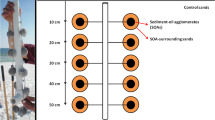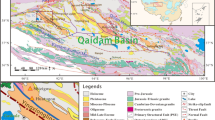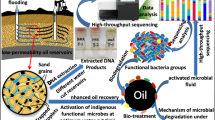Abstract
Biodegradation of crude oil in subsurface petroleum reservoirs is an important alteration process with major economic consequences1. Aerobic degradation of petroleum hydrocarbons at the surface is well documented2 and it has long been thought that the flow of oxygen- and nutrient-bearing meteoric waters into reservoirs was necessary for in-reservoir petroleum biodegradation3. The occurrence of biodegraded oils in reservoirs where aerobic conditions are unlikely4, together with the identification of several anaerobic microorganisms in oil fields5 and the discovery of anaerobic hydrocarbon biodegradation mechanisms6,7, suggests that anaerobic degradation processes could also be responsible. The extent of anaerobic hydrocarbon degradation processes in the world's deep petroleum reservoirs, however, remains strongly contested. Moreover, no organism has yet been isolated that has been shown to degrade hydrocarbons under the conditions found in deep petroleum reservoirs8. Here we report the isolation of metabolites indicative of anaerobic hydrocarbon degradation from a large fraction of 77 degraded oil samples from both marine and lacustrine sources from around the world, including the volumetrically important Canadian tar sands. Our results therefore suggest that anaerobic hydrocarbon degradation is a common process in biodegraded subsurface oil reservoirs.
This is a preview of subscription content, access via your institution
Access options
Subscribe to this journal
Receive 51 print issues and online access
$199.00 per year
only $3.90 per issue
Buy this article
- Purchase on Springer Link
- Instant access to full article PDF
Prices may be subject to local taxes which are calculated during checkout


Similar content being viewed by others
References
Connan, J. in Advances in Petroleum Geochemistry (eds Brooks, J. & Welte, D. H.) Vol. 1, 299–335 (Academic, London, 1984)
Atlas, R. M. & Bartha, R. Hydrocarbon biodegradation and oil-spill remediation. Adv. Microb. Ecol. 12, 287–338 (1992)
Palmer, S. E. in Organic Geochemistry (eds Macko, S. A. & Engel, M. H.) 511–534 (Plenum, New York, 1993)
Head, I. M., Jones, D. M. & Larter, S. R. Biological activity in the deep subsurface and the origin of heavy oil. Nature 426, 344–352 (2003)
Magot, M., Ollivier, B. & Patel, B. K. C. Microbiology of petroleum reservoirs. Antonie van Leeuwenhoek Int. J. Gen. Mol. Microbiol. 77, 103–116 (2000)
Boll, M., Fuchs, G. & Heider, J. Anaerobic oxidation of aromatic compounds and hydrocarbons. Curr. Opin. Chem. Biol. 6, 604–611 (2002)
Widdel, F. & Rabus, R. Anaerobic biodegradation of saturated and aromatic hydrocarbons. Curr. Opin. Biotechnol. 12, 259–276 (2001)
Röling, W. F. M., Head, I. M. & Larter, S. R. The microbiology of hydrocarbon degradation in subsurface petroleum reservoirs: perspectives and prospects. Res. Microbiol. 154, 321–328 (2003)
Evans, C. R., Rogers, M. A. & Bailey, N. J. L. Evolution and alteration of petroleum in Western Canada. Chem. Geol. 8, 147–170 (1971)
Horstad, I., Larter, S. R. & Mills, N. A quantitative model of biological petroleum degradation within the Brent Group reservoir in the Gullfaks field, Norwegian North Sea. Org. Geochem. 19, 107–117 (1992)
Larter, S. R. et al. The controls on the composition of biodegraded oils in the deep subsurface. Part 1: biodegradation rates in petroleum reservoirs. Org. Geochem. 34, 601–613 (2003)
Bastin, E. S. The presence of sulphate reducing bacteria in oil field waters. Science 63, 21–24 (1926)
Kartsev, A. A., Tabasaranskii, Z. A., Subbota, M. I. & Mogilevski, G. A. Geochemical Methods of Prospecting and Exploration for Petroleum and Natural Gas (English translation edited by Witherspoon, P. A. & Romey, W. D.) (Univ. California Press, Berkeley, California, 1959)
Zengler, K., Richnow, H. H., Rosselló-Mora, R., Michaelis, W. & Widdel, F. Methane formation from long-chain alkanes by anaerobic microorganisms. Nature 401, 266–269 (1999)
Rueter, P. et al. Anaerobic oxidation of hydrocarbons in crude oil by new types of sulfate-reducing bacteria. Nature 372, 455–458 (1994)
Magot, M., Connan, J. & Crolet, J.-L. Les bactéries des gisements pétroliers. La Recherche 25(268), 936–937 (1994)
Bennett, P. C., Siegel, D. E., Baedecker, M. J. & Hult, M. F. Crude oil in a shallow sand and gravel aquifer. I. Hydrogeology and inorganic geochemistry. Appl. Geochem. 8, 529–549 (1993)
L'Haridon, S., Reysenbach, A.-L., Glénat, P., Prieur, D. & Jeanthon, C. Hot subterranean biosphere in a continental oil reservoir. Nature 377, 223–224 (1995)
Elshahed, M. J., Gieg, L. M., McInerey, M. J. & Suflita, J. M Signature metabolites attesting to the in situ attenuation of alkylbenzenes in anaerobic environments. Environ. Sci. Technol. 35, 682–689 (2001)
Rios-Hernandez, L. A., Gieg, L. M. & Suflita, J. M. Biodegradation of an alicyclic hydrocarbon by a sulfate-reducing enrichment from a gas condensate-contaminated aquifer. Appl. Environ. Microbiol. 69, 434–443 (2003)
Gieg, L. M. & Suflita, J. M. Detection of anaerobic metabolites of saturated and aromatic hydrocarbons in petroleum-contaminated aquifers. Environ. Sci. Technol. 36, 3755–3762 (2002)
Zhang, X., Sullivan, E. R. & Young, L. Y. Evidence for aromatic ring reduction in the biodegradation pathway of carboxylated naphthalene by a sulfate reducing consortium. Biodegradation 11, 117–124 (2000)
Annweiler, E., Michaelis, W. & Meckenstock, R. U. Identical ring cleavage products during anaerobic degradation of naphthalene, 2-methylnaphthalene, and tetralin indicate a new metabolic pathway. Appl. Environ. Microbiol. 68, 852–858 (2002)
Phelps, C. D., Battistelli, J. & Young, L. Y. Metabolic biomarkers for monitoring anaerobic naphthalene biodegradation in situ. Environ. Microbiol. 4, 532–537 (2002)
Peters, K. E. & Moldowan, J. M. The Biomarker Guide (Prentice Hall, New York, 1993)
Aitken, C. M. . Identification of Non-Hydrocarbon Metabolites of Deep Subsurface Anaerobic Petroleum Hydrocarbon Biodegradation PhD thesis, Univ. Newcastle-upon-Tyne, UK (2004)
Watson, J. S. . Hydrocarbon and Carboxylic Acid Compositions of Crude Oil Biodegraded in Marine Systems PhD thesis, Univ. Newcastle-upon-Tyne, UK (1999)
Van der Linden, A. C. & Thijsse, G. J. E. The mechanisms of microbial oxidations of petroleum hydrocarbons. Adv. Enzymol. 27, 469–546 (1965)
Seewald, J. S. Organic-inorganic interactions in petroleum–producing sedimentary basins. Nature 426, 327–333 (2003)
Jones, D. M., Watson, J. S., Meredith, W., Chen, M. & Bennett, B. Determination of naphthenic acids in crude oils using non-aqueous ion exchange solid-phase extraction. Anal. Chem. 73, 703–707 (2001)
Acknowledgements
We thank I. Head, B. Bennett and H. Huang for comments and supporting data, and also the members of the BACCHUS biodegradation consortium for support, discussions and permission to publish. BACCHUS members include Norsk Hydro, Shell, Enterprise, Petrobras, TotalFinaElf, Exxon Mobil, JNOC, ConocoPhillips, BP Amoco and ChevronTexaco. We also thank H. Wilkes for discussions and the gift of succinate standards. We acknowledge support from the Natural Environment Research Council for research funds, including JREI awards and S.R.L. acknowledges additional support from NSERC and AIF.
Author information
Authors and Affiliations
Corresponding author
Ethics declarations
Competing interests
The authors declare that they have no competing financial interests.
Supplementary information
Supplementary Figure 1
Molecular structures and GC-MS ion fragmentation patterns for the methyl esters of 2-naphthoic acid and reduced 2-naphthoic acid metabolites. (PPT 94 kb)
Rights and permissions
About this article
Cite this article
Aitken, C., Jones, D. & Larter, S. Anaerobic hydrocarbon biodegradation in deep subsurface oil reservoirs. Nature 431, 291–294 (2004). https://doi.org/10.1038/nature02922
Received:
Accepted:
Issue Date:
DOI: https://doi.org/10.1038/nature02922
This article is cited by
-
Radiolytically reworked Archean organic matter in a habitable deep ancient high-temperature brine
Nature Communications (2023)
-
Taxonomic and functional trait-based approaches suggest that aerobic and anaerobic soil microorganisms allow the natural attenuation of oil from natural seeps
Scientific Reports (2022)
-
Non-syntrophic methanogenic hydrocarbon degradation by an archaeal species
Nature (2022)
-
Geologic controls on groundwater salinity reversal in North Coles Levee Oil Field, southern San Joaquin Valley, California, USA
Environmental Earth Sciences (2022)
-
New evidence for a hydroxylation pathway for anaerobic alkane degradation supported by analyses of functional genes and signature metabolites in oil reservoirs
AMB Express (2021)
Comments
By submitting a comment you agree to abide by our Terms and Community Guidelines. If you find something abusive or that does not comply with our terms or guidelines please flag it as inappropriate.



